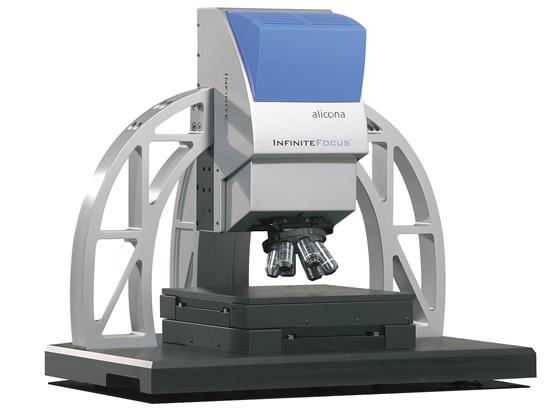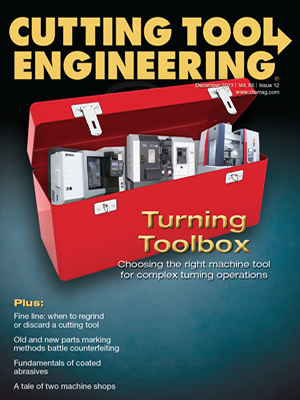END USER: OTEC Präzisionsfinish GmbH, +49 (7082) 491112, www.otec.de; OTEC Precision Finish Inc., (401) 398-0045, www.otecusa.com.
CHALLENGE: Achieve a higher accuracy and resolution when measuring cutting tools and components.
SOLUTION: An optical 3-D measurement system.
SOLUTION PROVIDER: Alicona Corp., (630) 372-9900, www.alicona.com.
Whether on a cutting tool or other machined component, a smooth surface can enhance a part’s functionality and aesthetics. OTEC Präzisionsfinish GmbH, Straubenhardt, Germany, offers drag finishing machines for imparting fine surface finishes on parts and cutting tools. (OTEC Precision Finish Inc. is located in North Kingston, R.I.)
As a specialist in mass finishing machines, OTEC has a wealth of experience with both optical and tactile measuring techniques. However, when OTEC needed higher-accuracy measurement of cutting edge radii and chipping—as well as rake, wedge and clearance angles—on cutting tools processed in its finishing machines, the existing systems didn’t provide the needed accuracy. Therefore, OTEC decided to replace its optical edge measurement system and tested various replacement options.
InfiniteFocus verifies dimensional accuracy of cutting tools by measuring radii, various angles, cutting edge chipping and deviation from the target geometry.
During testing, OTEC focused on achieving high accuracy when measuring cutting edges with radii smaller than 10µm, as well as ease of use, suitability for measuring a range of materials, easy positioning and changing of the tool or part to be measured, high-resolution measurement of highly polished surfaces and easy-to-understand documentation of measurement results. As a result, OTEC selected the InfiniteFocus optical 3-D measurement system from Alicona Imaging GmbH, Raaba/Graz, Austria. (Alicona Corp. is located in Bartlett, Ill.)
“The main reason to go with Alicona for edge measurement is quality,” said OTEC General Manager Soran Jota. “We achieve higher resolution and accuracy for a wider range of applications.”
Jota added that OTEC uses InfiniteFocus to traceably and repeatably measure the complex geometries of deburred, ground, smoothed and polished components, because a precise 3-D measurement technique is needed to define an edge in the micron range.

OTEC applies the InfiniteFocus high-resolution, optical 3-D measurement system from Alicona to traceably and repeatably measure complex geometries on components.
One of the most distinctive advantages InfiniteFocus provides is the measurement of the “real” edge contour, according to Alicona. The common approach for measuring edges is to simply fit a radius into a relatively large section of the edge itself. This is done in the “least squares sense” mode.
However, Alicona reported that its application work has shown the true edge is elliptic instead of being an ideal radius. Measuring an elliptic shape requires a significantly higher lateral and vertical resolution than commonly thought. With a vertical resolution down to 10nm, InfiniteFocus enables elliptic shapes to be fit into the edge region, providing a more detailed geometric reproduction. The fitting element consists of an elliptic segment with two adjacent tangent lines. Even when measuring complex shapes across large measurement areas, users achieve a vertical resolution of 10nm.
The main drawbacks of other optical measurement systems OTEC tested are the poor results when measuring radii below 10µm because of a low vertical resolution, high sensitivity against ambient light and unsuitability to measure polished components, according to OTEC.
In terms of tactile measurement, Alicona considers the measurement of only a single track, or profile, to be insufficient because this causes high measurement uncertainty. With InfiniteFocus, OTEC can measure edge radii smaller than 10µm and components with flank angles up to 85°. To measure those steep flanks, the system uses light coming from different directions. In addition, the measurement of the maximum flank angle is not restricted by the numerical aperture, according to Alicona. The numerical aperture of an objective characterizes the range of angles over which the system can accept or emit light. Alicona reports that its systems are not restricted to this range as they can use “external” light sources, such as a ring light, to support the measurement of complex geometries.
Also, Alicona stated that the system can measure highly polished components and materials with varying surface characteristics or reflection patterns. This is achieved using modulated light, providing optimal illumination throughout the entire measurement area. Therefore, operators can measure glossy, ground, rough, reflective and diffuse components.
As it is with the entire Alicona product range, InfiniteFocus combines the functionalities of a surface measurement system and a microscale coordinate measurement machine. This enables OTEC to measure the roughness and form of a component with one system.
According to Alicona, users of its measurement systems, such as OTEC, confirm that they benefit from the system’s high usability and intuitive handling. “In addition to the high measurement quality, we appreciate Alicona as a very user-oriented supplier,” Jota said. “The intuitive handling of the systems clearly shows an in-depth understanding of the users’ requirements.”
Related Glossary Terms
- 3-D
3-D
Way of displaying real-world objects in a natural way by showing depth, height and width. This system uses the X, Y and Z axes.
- clearance
clearance
Space provided behind a tool’s land or relief to prevent rubbing and subsequent premature deterioration of the tool. See land; relief.
- micron
micron
Measure of length that is equal to one-millionth of a meter.
- rake
rake
Angle of inclination between the face of the cutting tool and the workpiece. If the face of the tool lies in a plane through the axis of the workpiece, the tool is said to have a neutral, or zero, rake. If the inclination of the tool face makes the cutting edge more acute than when the rake angle is zero, the rake is positive. If the inclination of the tool face makes the cutting edge less acute or more blunt than when the rake angle is zero, the rake is negative.


